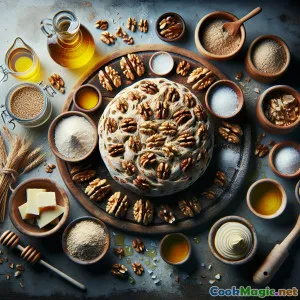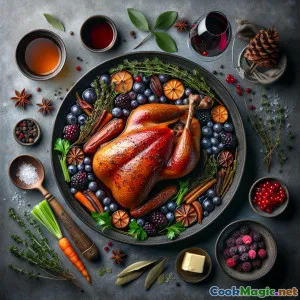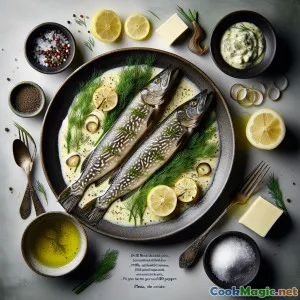
Smaragd-Bauernbrot mit Roggen und Walnüssen aus Podhale
(Emerald Podhale Rye & Walnut Country Bread)
(0 Bewertungen)0
3,332
Juli 17, 2025
Problem melden
Zutaten
-
300 grams Roggenmehl
(Roggenmehl aus Steinmahlung oder Roggenvollkornmehl)
-
200 grams Weizenmehl für Brot
(Weißbrotmehl mit hohem Proteingehalt für Struktur)
-
100 grams Gehackte Walnüsse
(Grob gehackt)
-
2 teaspoons Kümmelsamen
(Optional, aber traditionell)
-
7 grams Aktive Trockenhefe
(1 Standardpackung)
-
10 grams Meersalz
(Feines Meersalz bevorzugt)
-
1 tablespoon Honig
(Verleiht Tiefe und eine subtile Süße; Ahornsirup als Ersatz verwenden.)
-
350 ml Warmes Wasser
(Etwa 38–40°C zur Aktivierung der Hefe.)
-
1 tablespoon Olivenöl
(Hilft Feuchtigkeit zu bewahren und die Krustenfarbe zu verbessern)
(Roggenmehl aus Steinmahlung oder Roggenvollkornmehl)
(Weißbrotmehl mit hohem Proteingehalt für Struktur)
(Grob gehackt)
(Optional, aber traditionell)
(1 Standardpackung)
(Feines Meersalz bevorzugt)
(Verleiht Tiefe und eine subtile Süße; Ahornsirup als Ersatz verwenden.)
(Etwa 38–40°C zur Aktivierung der Hefe.)
(Hilft Feuchtigkeit zu bewahren und die Krustenfarbe zu verbessern)
Nährwerte
- Portionen: 8
- Portionsgröße: 1/8 Laib (ca. 75 g)
- Calories: 224 kcal
- Carbohydrates: 39 g
- Protein: 6 g
- Fat: 5 g
- Fiber: 4 g
- Sugar: 2 g
- Sodium: 295 mg
- Cholesterol: 0 mg
- Calcium: 22 mg
- Iron: 1.4 mg
Anweisungen
-
1 - Hefe aktivieren:
Hefe und Honig (falls verwendet) in warmes Wasser geben. 10 Minuten beizeite stellen, bis es schäumt.
-
2 - Trockene Zutaten vermengen:
In einer großen Schüssel Roggenmehl, Brotmehl, Salz und Kümmelsamen mischen (falls verwendet).
-
3 - Teig zum Formen:
Gießen Sie die Hefemischung und das Olivenöl (falls verwendet) über die trockenen Zutaten. Rühren Sie mit einem robusten Löffel, bis alles gut vermischt ist.
-
4 - Walnüsse hinzufügen, kneten:
Vermengen Sie Walnüsse. Legen Sie den Teig auf eine leicht bemehlte Arbeitsfläche und kneten Sie ihn, bis er glatt ist (7–10 Minuten).
-
5 - Erster Aufgang:
Den Teig in eine eingefettete Schüssel geben. Abdecken und an einem zugfreien Ort gehen lassen, bis er sich verdoppelt hat (ca. 2 Stunden).
-
6 - Formen und zweiter Aufstieg:
Den Teig niederdrücken, zu einem runden Laib formen. Auf Backpapier legen oder in ein bemehltes Gärkörbchen legen. Abdecken und gehen lassen, bis er aufgeht und fluffig ist, ca. 1,5 Stunden.
-
7 - Ofen vorheizen:
Während der letzten Gare den Ofen auf 230°C (446°F) vorheizen und einen gusseisernen Schmortopf mit hineinlegen.
-
8 - Einschneiden und backen:
Verteilen Sie den Teig sanft in einem heißen Dutch Oven; bestäuben Sie die Oberfläche mit Mehl und schneiden Sie die Oberseite ein. Decken Sie ihn ab und backen Sie 35 Minuten, dann nehmen Sie den Deckel ab und backen weitere 10 Minuten, um eine tiefe Kruste zu erhalten.
-
9 - Abkühlen und Servieren:
Nehmen Sie das Brot heraus und lassen Sie es mindestens 30 Minuten auf einem Drahtgitter abkühlen, bevor Sie es in Scheiben schneiden, um die Textur fertig zu entwickeln.
Hefe und Honig (falls verwendet) in warmes Wasser geben. 10 Minuten beizeite stellen, bis es schäumt.
In einer großen Schüssel Roggenmehl, Brotmehl, Salz und Kümmelsamen mischen (falls verwendet).
Gießen Sie die Hefemischung und das Olivenöl (falls verwendet) über die trockenen Zutaten. Rühren Sie mit einem robusten Löffel, bis alles gut vermischt ist.
Vermengen Sie Walnüsse. Legen Sie den Teig auf eine leicht bemehlte Arbeitsfläche und kneten Sie ihn, bis er glatt ist (7–10 Minuten).
Den Teig in eine eingefettete Schüssel geben. Abdecken und an einem zugfreien Ort gehen lassen, bis er sich verdoppelt hat (ca. 2 Stunden).
Den Teig niederdrücken, zu einem runden Laib formen. Auf Backpapier legen oder in ein bemehltes Gärkörbchen legen. Abdecken und gehen lassen, bis er aufgeht und fluffig ist, ca. 1,5 Stunden.
Während der letzten Gare den Ofen auf 230°C (446°F) vorheizen und einen gusseisernen Schmortopf mit hineinlegen.
Verteilen Sie den Teig sanft in einem heißen Dutch Oven; bestäuben Sie die Oberfläche mit Mehl und schneiden Sie die Oberseite ein. Decken Sie ihn ab und backen Sie 35 Minuten, dann nehmen Sie den Deckel ab und backen weitere 10 Minuten, um eine tiefe Kruste zu erhalten.
Nehmen Sie das Brot heraus und lassen Sie es mindestens 30 Minuten auf einem Drahtgitter abkühlen, bevor Sie es in Scheiben schneiden, um die Textur fertig zu entwickeln.
Mehr über: Smaragd-Bauernbrot mit Roggen und Walnüssen aus Podhale
Introduction
Podhale Rye and Walnut Rustic Bread is a tribute to rustic Eastern European country loaves, inspired by the earthy harvests and simple but profound home baking traditions of the Podhale region in southern Poland. This bread encapsulates Old World culinary wisdom—a time when bread was nourishment, centerpiece, and pride for rural families across Polish highlands.
The heady aroma of rye, pulsing with nutty sweetness from walnuts and a brush of caraway, harkens back to bread you’d encounter in mountain village markets or alongside cheese and mushroom stews shared at timber-clad inns. What makes this recipe unique is its blend of rich rye with wheat, providing an accessible crumb for modern bakers without losing Old Country character. The addition of walnuts not only amplifies texture but harnesses Podhale’s tradition of foraging for nuts and herbs.
Tips, Notes & Substitutions
- Flour: Always use the best-quality rye flour you can get; stone-ground gives an authentic, earthy taste and solid nutrition. In a pinch, dark rye can be blended with all-purpose, but ratios may need tweaking as rye absorbs more moisture.
- Nuts: Walnuts should be coarsely chopped; their visiting crunch provides dynamic mouthfeel in each bite. If walnuts aren’t available, hazelnuts (common to Carpathia) are a tasty substitute.
- Crust: For an extra crisp, crackly crust, bake the bread in a pre-heated Dutch oven and leave the lid off for the final 10 minutes for deeper color—and a mesmerizing aroma.
- Salt & Sweeteners: Finer salt disperses better; honey isn’t vital but disguises the sometimes-acidic rye and boosts browning. Maple syrup lends a smoky undertone.
- Caraway: While optional, caraway is time-honored in Central European rye loaves and lends an unmistakeable tingle and deformal bread-smell many Eastern Europeans associate with home.
History & Cultural Significance
In the foothills of the Tatra mountains, bread is more than a daily bake. Once a way of life for highlanders—shepherds, cheese makers, artisans—the Podhale region’s dark breads fueled their hard, windy, communal living. Grain had to be stretched; supplements like mashed potato, seeds, and sometimes whatever orchard windfall (namely walnuts) could enrich sparse cupboards. Sundays and harvest feasts still see loaves cross icons and prayer candlelight, a centerpiece of gratitude and togetherness.
This take on the Podhale loaf is a blend of tradition and modern comfort—combining enough wheat flour for a soft crumb with distinct rye tang, then adding encased, roasted walnuts that offer unexpected excitement as you slice through.
Personal Thoughts & Serving Ideas
This bread, while sublime warm and buttered, reaches its zenith when paired with smoked cheese (try Oscypek), thick honey, or cold mountain trout pâtés. Leftover slices transform into hearty toast or grids of rye-and-walnut salads. In winter, I love it next to borscht; in summer, simply torn apart under alpine wildflower meadows.
What’s magical is how the nuts caramelize as the bread bakes, scenting the crust and giving a depth not found in mass-produced loaves. It’s as deeply nested in Polish tradition as it is friendly to modern, health-focused kitchens that value fiber, ancient grains, their slow nutrition, and their careful stories.
Final Note
Bake this bread not just for its taste, but because its aroma alone can unite friends and neighbors for comfort and good talks. Both simple and sophisticated, the Podhale Rye and Walnut Rustic Bread invites you to slow down and savor.
























